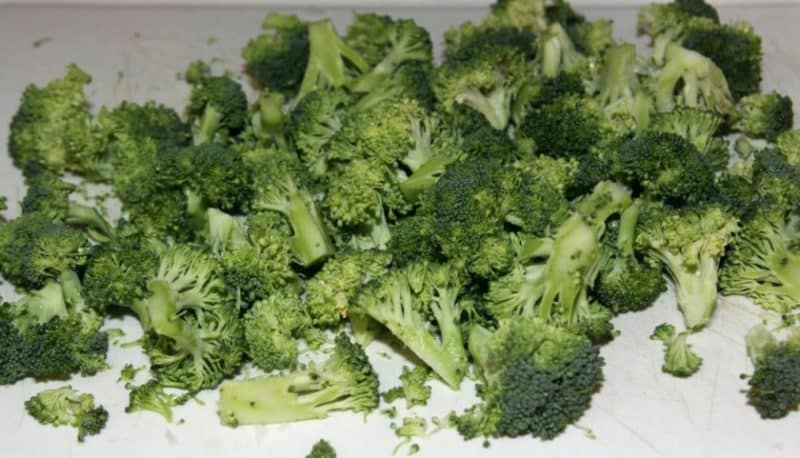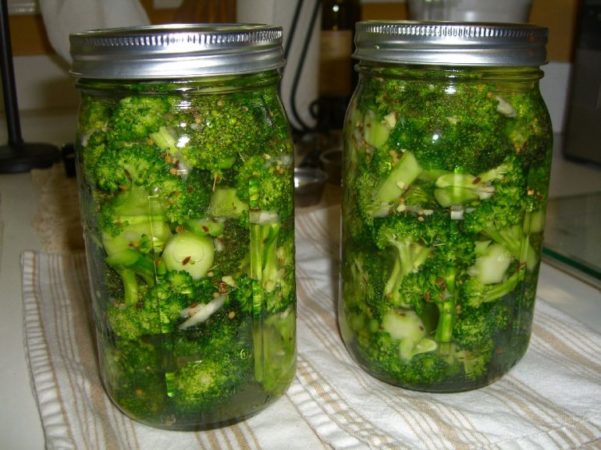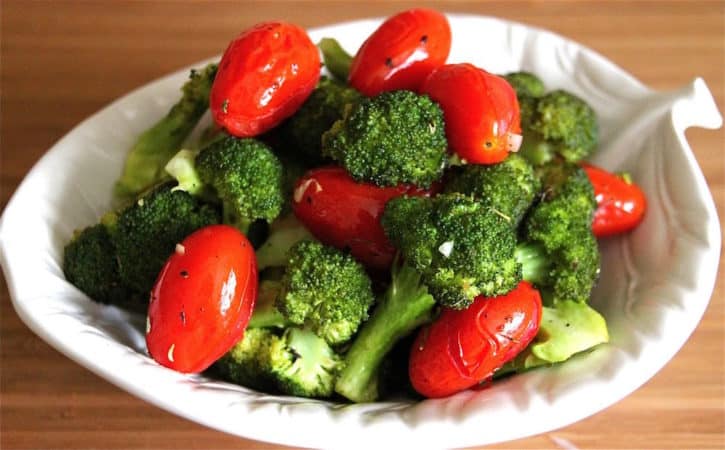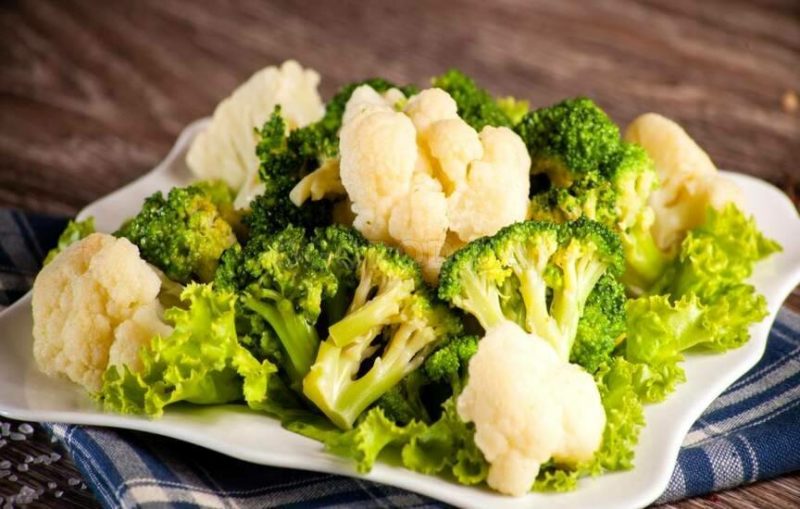A selection of recipes from experienced housewives: how to pickle broccoli simply and tasty
Not every housewife cans broccoli. According to the majority, such preparations turn out to be too bland. However, there are many ways to prepare delicious winter dishes from this healthy vegetable. Read our article about pickling broccoli in jars for the winter.
Selecting and preparing broccoli for pickling

The choice of broccoli heads for preservation is carried out taking into account a number of requirements:
- freshness;
- hardness;
- integrity, absence of any signs of damage or decay;
- the presence of a round shape, bright green color, while the tops of the inflorescences may be purple;
- absence of yellowness, as well as gray and brown spots.
It is not recommended to preserve unripe heads of cabbage as they will be too soft and not crispy. The same can be said about overripe vegetables - they are poorly cooked and become tough.
For pickling, vegetables with a minimum number of branches, weighing 500-700 g and 20 cm in diameter are most preferable.
Selected cabbage is poured with warm salted water and soaked for 20 minutes to get rid of insects hiding in the vegetable.
Further preparation for conservation includes several actions:
- washing, removing dirt;
- elimination of damaged fragments;
- division into separate inflorescences;
- drying.
Some recipes call for blanching in hot water for 4 minutes followed by rinsing under cold running water.
Important! Wet heads of broccoli on store shelves indicate that they were immersed in water to simulate lost freshness.
How to pickle broccoli: the classic way
The simplest way to preserve broccoli is pickling, which perfectly preserves the color and taste of vegetables.
Vinegar is used as a preservative to suppress pathogenic microorganisms. Added spices add flavor and unique taste.

Ingredients and proportions
For pickling according to the classic recipe, you will need the following ingredients:
- 400 g broccoli;
- 2 carrots;
- 6 cloves garlic;
- fresh dill;
- 2 bay leaves;
- 15 black peppercorns;
- 10 tbsp. l. granulated sugar;
- 1 liter of water;
- 4 tbsp. l. salt;
- 200 g sunflower oil;
- 1 tbsp. l. vinegar (9%).
Step-by-step instruction
Cooking technique:
- Divide the head of cabbage into inflorescences, rinse thoroughly and dry (remove damaged fragments).
- Cut carrots into cubes or rings.
- Chop the dill.
- Pass the garlic through a press.
- Prepare jars and lids: rinse and sterilize.
- Mix cabbage, garlic, carrots and herbs in one container, then place them in jars.
- Place sugar, butter, salt and spices in a saucepan with water.
- Boil for 8-10 minutes.
- Finally add acetic acid.
- Pour boiling marinade into jars of vegetables and herbs and tighten.
The cooled pieces are left for 2 days in a dark place at room temperature, and then placed in the refrigerator or taken to the basement permanently. storage.
Recipe Variations
There are many options for broccoli preparations: with the addition of tomatoes, carrots, bell peppers, and asparagus. In addition, this cabbage is marinated with berries or mushrooms, and a stew is also prepared from it for the winter.For lovers of spicy dishes, recipes with capsicum and garlic are relevant.

Fast way
Required components:
- 1 kg of broccoli;
- 1 liter of water;
- 350 ml vinegar (9%);
- 1 tbsp. l. salt;
- 1 tbsp. l. Sahara.
How to pickle broccoli:
- Rinse the heads of cabbage and check for damage.
- Dissolve 4 tsp in 1 liter of water. salt, pour over vegetables to remove insects.
- Divide complex inflorescences into simple ones, while simultaneously eliminating thick leaves and stems.
- Place the broccoli in boiling water for 5 minutes and then in ice water.
- Prepare a marinade of sugar and salt by dissolving them in hot water.
- Place the heads of cabbage in prepared jars and pour in the marinade.
- Add vinegar.
- Pasteurize for 15 minutes at a temperature of +85…+90°C.
- Seal the jars with lids, turn them upside down, and wrap them in a towel.
- Place the cooled pieces in a permanent storage location.
With greens
For preservation you will need:
- 2 kg of broccoli;
- 15 g granulated sugar;
- 20 g salt;
- 2 liters of water;
- vinegar 9% based on 2 tbsp. l. 1 liter capacity;
- 2 dill umbrellas;
- 1 branch basilica;
- 1 pod of hot pepper;
- 5 black peppercorns.
Sequencing:
- Divide the cabbage into several inflorescences, rinse, cut off any damage.
- Sterilize the jars by first washing them with baking soda.
- Boil the lids in water.
- Wash and chop the greens.
- Peel and chop the garlic.
- Prepare the marinade: add sugar and salt to boiling water and, 5 minutes after the start of cooking, add acetic acid.
- Place broccoli, garlic and herbs in jars, and then pour in the marinade.
- Prepare a suitable container for sterilization and place a special grid or towel on the bottom.
- Sterilize for at least 40 minutes.
To ensure that hot vegetables are well saturated with brine, it is recommended to wrap the lidded jars in a thick towel.
Important! The ratio of cabbage and marinade should be 60:40.
In Korean

This Asian style recipe includes the following ingredients:
- 500 g broccoli;
- ½ tsp. coriander;
- 300 ml water;
- 1 large carrot;
- 4 cloves of garlic;
- 30 ml vinegar;
- ground black and red pepper (to taste);
- ½ tsp. salt;
- 2 tbsp. l. vegetable oil;
- 1 tsp. granulated sugar;
- 2 sweet peppers.
How to add salt:
- Trim the cabbage leaves, rinse, and disassemble the head of cabbage into several simple inflorescences.
- Dissolve 1 tbsp in a container with water. l. salt, put the vegetable there, leave for 20 minutes. Insects present in the inflorescences will float to the surface.
- Place the inflorescences in a colander and place in boiling water for 2 minutes. Thanks to this procedure they will become softer.
- Hold the colander with the cabbage under cold running water; as a result, the broccoli will acquire an attractive bright green hue.
- Wash, remove seeds and chop the bell pepper. To make the appetizer look more appetizing, it is recommended to use contrasting colors of pepper.
- Peel and chop fresh carrots on a special grater so that you get thin and long strips.
- Pass the garlic through a press.
- Place all vegetables in a large container and mix.
- Add spices, granulated sugar and salt to the vegetable mixture, and then mix thoroughly.
- Pour vinegar, vegetable oil and water into the same container. Stir and let stand for 3 hours, so the vegetables are well marinated.
- Place the resulting snack in clean jars (0.5 l) and fill with brine to the top.
- Cover the containers with lids, place in a pan filled with water and sterilize for approximately 20 minutes.
- Cover with lids, tighten as tightly as possible and turn upside down. After a day, transfer to a dark and cool place for storage.
With basil and chili pepper
This cabbage recipe is great for long-term storage.
Required components:
- 2 kg of broccoli;
- ½ bunch of basil;
- 8 garlic cloves;
- several branches dill;
- 50 ml vinegar;
- 2 liters of water;
- 1 chili pepper;
- 30 g salt;
- 80 g sugar.
Cooking process:
- Prepare the inflorescences: wash, sort and soak for 30 minutes in a saline solution, then remove from it and dry.
- Blanch for 5-7 minutes in boiling water, then place in ice water and leave until completely cool.
- Place garlic, basil, dill, salt, hot pepper and sugar in sterilized jars.
- Pack all components tightly and pour vinegar.
- Pour boiling water into the jars with the contents to the brim and place on low heat.
- From the moment of boiling, sterilize for 20 minutes.
- Seal with lids, turn over and wrap warmly.
- After a day, store in a dark and cool place.
Broccoli salad for the winter

Canned broccoli salad goes great with meat and fish dishes. Of the many recipes for such a snack, vegetable is the most common and easiest to prepare.
To prepare it you will need:
- 1 kg cabbage;
- 5 tomatoes;
- 2 carrots;
- 3 sweet peppers green, red, yellow;
- ½ tbsp. granulated sugar;
- 4 cloves of garlic;
- 1 tbsp. l. salt;
- 1 hot pepper;
- 1 tbsp. l. wine vinegar;
- 1 liter of water;
- 1 tsp. mustard powder;
- 1 tbsp. l. rosemary, basil and tarragon.
Cooking method:
- Peel and finely chop the bell pepper.
- Crush the garlic with a press.
- Pour boiling water over cabbage.
- Mix the chopped vegetables thoroughly and place in pre-sterilized jars.
- To obtain a spicy sauce, add spices, vinegar, salt, sugar and mustard to boiling water, then boil the mixture again.
- Pour the filling into containers and seal them with lids.
- After complete cooling, store in a cool place.
Hot peppers make the salad spicy.
Assorted broccoli and tomatoes

The preparation will be an ideal side dish for meat dishes. It includes:
- 1.5 kg of broccoli;
- 1.5 kg of small and dense tomatoes;
- 1.5 kg of sweet pepper;
- fresh parsley;
- 5 cloves of garlic;
- mustard seeds (at the rate of ½ tsp per 3 liter container);
- 4 bay leaves;
- 150 g sugar;
- 2.5 tsp. salt;
- 120 ml bite (9%).
Cooking sequence:
- Prepare greens and vegetables: rinse, peel, disassemble the cabbage into small inflorescences.
- Cut the pepper into large rings.
- Place the cabbage in boiling water, then cook for 3-4 minutes.
- Boil water in a separate container, add sugar and salt and mix well.
- Place parsley, garlic, bay leaf and mustard seeds in sterilized jars, and peppers, cabbage and tomatoes on top.
- Pour the contents of the jars with the prepared marinade and leave for 20 minutes without covering.
- Pour the marinade back into the pan, bring to a boil again and pour into the jars again.
- Add vinegar to the pickles, cover with lids and roll up.
Warm preparations are left wrapped in a blanket for 2 days, after which they are stored in a cool place.
With cauliflower
Thanks to the combination of vegetables, the preparation prepared according to this recipe has a unique taste and aroma.

Ingredients:
- ½ kg broccoli;
- 0.3 kg cauliflower;
- 0.3 kg of sweet peppers of different colors;
- garlic (3 cloves per 1 jar);
- 2 tsp. salt;
- 2 tsp. Sahara;
- apple cider vinegar (2 tbsp for 1 serving);
- ½ tsp. citric acid;
- ½ liter of water.
Cooking algorithm:
- Wash, peel and cut vegetables.
- Dissolve citric acid in a saucepan with boiling water and add cauliflower and broccoli there.
- Blanch for 2 minutes, then place in containers prepared for seaming.
- Add garlic that has been pressed through a press to the jars of vegetables.
- To obtain the marinade, dissolve salt and sugar in water.
- Place the pepper cut into strips on top of the cabbage and garlic.
- Pour the filling into the jars and lastly – vinegar.
- Sterilize uncapped containers over low heat for 15 minutes.
- Roll up the lids and store.
Features of storing broccoli preparations
Broccoli pickles are stored in dark rooms at temperatures up to +15°C, otherwise they will quickly deteriorate. The shelf life of the preserved product is 1 year.
Important! Snacks prepared according to a recipe that does not require sterilization and lidding are stored in the refrigerator for no more than 60 days.
Advice from experienced housewives
When preparing broccoli pickles, you should listen to several recommendations:
- pack the inflorescences as tightly as possible into the jars, since due to the softening of the vegetables during the pickling process, a lot of free space remains;
- Boil the cabbage for 5 minutes in salted water, otherwise it will be harsh;
- After blanching, place the inflorescences in cold water - this will preserve their bright green color;
- For lovers of spicy dishes, increase the amount of vinegar added, especially for recipes with mushrooms.
Properly prepared salted broccoli is crunchy in the teeth, does not become soggy and retains its taste properties, enhanced by spicy components.
This is interesting:
The benefits of broccoli sprouts and methods for germinating seeds
Is broccoli good for weight loss and in what form and quantity should it be included in the diet?
Step-by-step guide on how to grow broccoli at home correctly
Conclusion
When preparing broccoli, it is important not only to choose the ingredients wisely, but also to strictly adhere to the cooking algorithm. If you don’t have experience in pickling and don’t have the time to become familiar with this process in detail, you should give preference to other cooking methods: drying, sourdough or freezing.